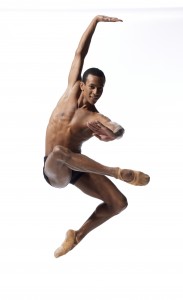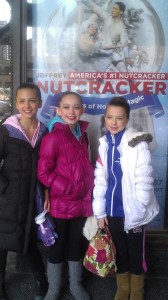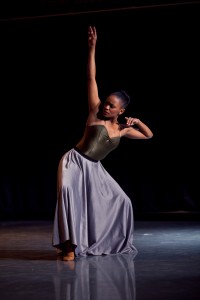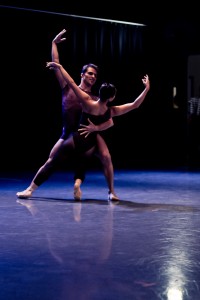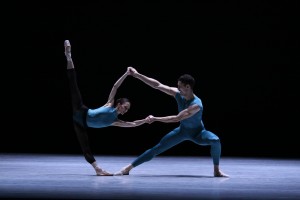
Joffrey dancers Victoria Jaiani & Fabrice Calmels in William Forsythe's "In the Middle, Somewhat Elevated". Photo by Herbert Migdoll.
“Just music, head, hands,” he says to the dancers. It’s Monday morning and the Joffrey Ballet dancers are ready for a run-through of William Forsythe’s 1987 work, In the Middle, Somewhat Elevated. They’ve learned all the steps and had two days off over the weekend. Some dancers have been sick, so répétiteur Glen Tuggle tells them to take it easy. “Mark it, but always do head and hands.” Even marking, you can see the difficulty of the choreography. The intricate hand grips, the off-center leans, the speed. This 22-minute abstract piece pushes dancers to their limits and then asks them to go one step more. Stretch their technique to the limit, or “tear it apart”.
Tuggle, currently the Ballet Master/Teacher with Les Ballets de Monte-Carlo, has danced with Harkness Ballet (disbanded 1975), Zurich Opera, Stuttgart Ballet and Frankfurt Ballet (disbanded 2004). He met William (Bill) Forsythe while in Stuttgart at the age of 22. Forsythe had just started to choreograph. Fast forward 23 years and Tuggle has the enjoyable task of teaching/setting Foysythe works around the world. Having danced Middle for numerous years, he is intimately familiar with the work. Originally created for the Paris Opera Ballet, Forsythe cast a young Sylvie Guillem in one of the lead roles and made her a star. I sat down with Tuggle at the Joffrey Tower to discuss the famous work and working with our home town company.
How is it working with the Joffrey dancers?
Wonderful! I’ve been having a great time. We’ve all been having a great time. I set ‘Middle’ in 17 days. I know it, of course, but for the dancers to learn it that fast is amazing.
What is the most difficult thing about teaching it?
In ‘Middle’, we take the classical language and stretch it – tear it apart. Some of the classic lines…you see them, but then they go to a further degree and you don’t recognize them anymore. I think the hardest thing about teaching it is helping the dancers understand how far they can go. Giving them enough confidence in themselves to be comfortable doing that.
How do you do that?
I find most of my work, whether it’s setting ‘Middle’ or the other ballets I set for Forsythe or teaching class, is to care for the dancers…let them know that I believe in them, that I care for them. It’s a dialogue we have together as a teacher or rehearsal director or coach. It’s quite intimate. I find one of the most interesting parts of my job is the psychological aspect of working with dancers either individually or as a group. It takes a lot of thought to help them understand how far they can go and to trust themselves. I’ve worked with many dancers who’ve been damaged by the schools they went to and they hear “No” way too often in their career. I learned from some of the most influential people in ballet over the last 30 years that the use of language is extremely important when working with dancers. You try not to use too many negatives. There is always a way of saying things without “No” being in it. Especially if you see a dancer who is already not confident. Even if they have the everything, the beauty, the body, the technique…they don’t actually believe what they see. You have to really convince them that they are beautiful.
Why do you enjoy setting this particular work?
It’s always so fulfilling for me, even after 23 years of working with ‘Middle’, because the dancers have such a great time and you’re introducing them to a world they aren’t familiar with in Bill’s works. He says, “Be where you are.” If you’re not where you want to be, dance and be where you are. Technically he’ll let them go for something really difficult, because they’re just going to walk out of it. So if it works, you can say, it really worked tonight, but if it doesn’t work, no one will know. The audience won’t know. You’re not usually asked to do that. I’ve seen some phenomenal things happen in ‘Middle’, where the people themselves couldn’t believe they did it.
Is it just an abstract dance or is there meaning behind it? What is the audience supposed to take away?
I think he just wants them to be stimulated by it and see the degree and the level of dancing that’s possible when one is given the opportunity and given the freedom to tear it apart. There is a lot of freedom in ‘Middle’. The last pas de deux (which is just phenomenal), he said it’s like you’re in a disco and just tearing it apart. It’s so technically so difficult, because of the speed.
Also on the program, Christopher Wheeldon’s beautiful After the Rain, which made its Joffrey premiere in 2010 and Wayne McGregor’s Infra, inspired in part by the 2005 London subway bombings. Joffrey will be the first company to perform the work outside the Royal Ballet, where it premiered in 2008.
Joffrey Ballet presents Winter Fire – Feb 15 – 26
The Auditorium Theatre, 50 E Congress
Tickets are $25 – $149. Call 800.982.2787 or visit ticketmaster.com

